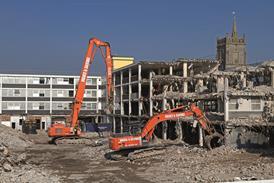Fitzpatrick is overseeing hundreds of workers and complex earthworks to build 92 ha of greenhouses that will supply tomatoes year round.
Sun, sand, ice cream, happy smiling faces... wouldn’t it be great if the summer lasted forever? Well, on a large plot of land in the Kent countryside the dream is about to become reality.
Located on a hill in Birchington, north-east Kent, Thanet Earth will become the UK’s largest greenhouse complex. Comprising seven buildings and covering a 92 ha plot of land – equivalent to about 80 football pitches – it will provide enough warmth and artificial light to harvest tomatoes year-round and peppers and cucumbers continuously from February to September. Once completed in November, it will extend the UK’s crop of salad vegetables by 15%.
Building the greenhouses are several Dutch contractors working for a consortium of Dutch growers and UK client Fresca. According to Thanet Earth MD Steve McVickers the greenhouses are simple to erect, being similar to those on sale at B&Q, only bigger. Each greenhouse takes roughly 11 weeks to complete – three weeks for foundations, four weeks for the frame and another four for the glazing. When CM visited the site in June the first building was already close to completion.
That’s only half the story, however. For principal contractor Fitzpatrick, ensuring work runs smoothly and safely on a site containing as many as 200-300 people, coupled with a massive earthworks operation that includes one of the largest archaeological digs in the UK, is a major challenge.
‘With such a huge area of land to prepare for the erection of the greenhouses, the earthworks are the critical path on this project,’ says Deon Scholtz, project manager for Fitzpatrick. Initially the whole site was stripped of its topsoil and any uncovered archaeological features were noted by members of the Canterbury Archaeological Trust in a so-called ‘strip and map’ operation. Subsequently more detailed archaeological digs began.
In areas where the archaeological work has been completed, chalk excavation is carried out – about 700,000m3 of it in total – cutting high areas to fill lower areas to create a solid platform for each of the greenhouses. Topsoil stockpiled from the initial strip is then laid on top to create a base for the structures.
Using Bobcat T300s, operators drill 1.5m-deep, 500mm-wide foundation holes into the chalk at 8m x 5m centres. Concrete is then poured in and a mini pile is set into the concrete to create solid footings. Around the perimeter of each greenhouse a low concrete ring beam is also poured at ground level.
Next the steel/aluminium frame contractors are mobilised to work from one end to the other using scissor lifts and simple elbow grease to hoist the lightweight structure into place. Then the glass arrives. ‘Each glass panel measures around 1m x 2m, which is quite large to maximise the amount of light that can enter,’ says Scholtz.
Fitzpatrick began its involvement with Thanet Earth as a civils contractor, responsible for earthworks and services installation. Later Fresca extended its role extend to construction, design and management (CDM). The sheer scale of the workforce that has descended on the site makes sense of Fresca’s decision to expand Fitzpatrick’s role to include CDM.
It’s at the interfaces between the different teams that we come in as managers
Deon Scholtz, Fitzpatrick
Each Dutch grower has its own appointed contractor and each contractor its appointed foundation, framework, glazing and M&E team. Then there are the archaeologists and services teams. ‘It’s hard to believe the number of people that come through the site each day. At any one time we could have between 150 and 250 operatives and we’re still in the early stages,’ says Scholtz.
‘Although each Dutch contractor effectively subcontracts work from us they drive their own programme of works and manage their own costs,’ adds Scholtz. ‘It’s at the interfaces between the individual plots and between different teams that we come in as managers, also enforcing health and safety.’
Each contractor works on their own individual plot of land, but because of the proximity of plots, it often means encroaching on another contractor’s area. ‘If contractors want to use a crane outside their plot, for example, they run it past us and we work out whether it needs a lay down area and agree any additional costs,’ says Scholtz.
‘Of course, we also have to get it cleared with the contractor whose plot is being infringed upon. We might also have to speak to the muck shifters or the drainage contractors and ask them to work elsewhere during that period.’
Health and safety is a big responsibility, with Fitzpatrick providing the welfare set ups for each building, including site offices, canteens, toilets, generators and water supplies. A full-time health and safety officer vets all contractors’ method statements and ensures all operatives are trained accordingly. All key operatives, site managers and site foremen also go through the five-day CITB training course to ensure they understand UK legislation and can pass on requirements to their operatives.
It’s a well-planned process, but not everything has been plain sailing, as Scholtz explains: ‘Meeting the earthworks outputs has been the biggest challenge. We’ve got to shift a million cubic metres in total, which is difficult enough without having to do it around an extensive archaeological dig.’
Only after work got under way did Fitzpatrick realise the scale of excavations that were necessary. Fresca, had allocated a provisional sum for detailed archaeological digs, but that has now been exceeded ten times over. ‘It’s everywhere. If all you want to do is put a pipe in the ground, you have to get the area checked and mapped before it can be signed off by Kent Heritage,’ says Scholtz.
The result is a delay of a few weeks, but Stoltz is confident the time can be made up. ‘The secret is trying to programme ahead of yourself, thinking where will I be digging next to get the production up to meet the deadline. We also have weekly site meetings with the contractors to ensure everyone’s needs are being met and that we’re not falling behind programme.’
At this point Scholtz cuts our interview short. ‘I’m afraid I can’t answer any more questions ... I’ve got 30 men to induct,’ he says with a smile.
Source
Construction Manager




















No comments yet